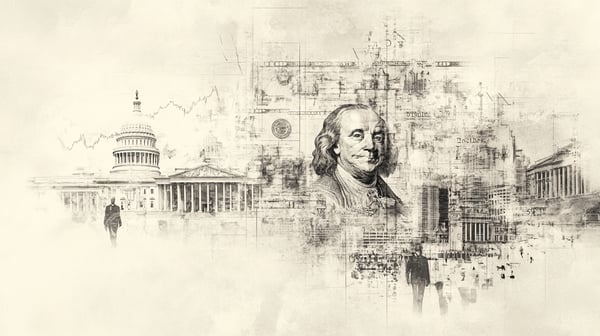Central Banks don't matter and this will not change in the foreseeable future

The rise and fall of the shadow banking system—as chronicled by Zoltan Pozsar in his seminal 2008 article—offers a crucial case study in how modern financial innovation evolved under faulty assumptions, and ultimately destabilized the global monetary order. From a systemic perspective, the story is not merely one of securitization gone awry, but a profound reshaping of credit intermediation around a shadowy infrastructure of nonbank balance sheets, collateral transformations, and market-based liquidity creation—one which global authorities neither understood nor controlled. This system’s collapse triggered cascading disruptions still reverberating through our monetary order today.
Prior to 2008, the securitization business experienced an explosive ascent. At its core was the “originate-to-distribute” model of banking, replacing the traditional “originate-to-hold” approach. Banks, no longer constrained by the need to warehouse loans on their balance sheets, sold them into capital markets via broker-dealers. These dealers structured the loans—ranging from residential mortgages to corporate debt—into securities such as mortgage-backed securities (MBS) and more complex collateralized debt obligations (CDOs), which were then sold to investors. This transformation was not merely a shift in tactics but a wholesale reconfiguration of the banking architecture, as credit intermediation migrated off-balance-sheet into a growing shadow banking system.
The primary drivers behind this transformation were manifold. Regulatory arbitrage, particularly in response to the 1988 Basel Accord, incentivized banks to shed risky assets and minimize capital charges through securitization. At the same time, persistently low interest rates and a global “glut of savings” created a desperate demand for yield among institutional investors, who were increasingly attracted to the tranching structure of CDOs that offered higher yields on equity and mezzanine tranches. Investors—ranging from insurance companies to pension funds—mistook these yields as risk-adjusted returns, assuming that financial engineering could truly diversify risk rather than simply disguise and repackage it.
Crucially, the entire structure of this system assumed deep and persistent liquidity in money markets and an uninterrupted daisy chain of asset originators, packagers, and buyers. It depended on liquid repo markets to fund warehousing of securities, and on continuous demand from CDO managers and structured investment vehicles (SIVs) to roll over short-term liabilities against long-term, illiquid assets. The “underlying assumption” was that market liquidity and confidence were near-permanent features of the financial landscape—a deeply flawed presumption.
The architecture of this new system created a superficially efficient mechanism for credit dispersion but introduced fatal fragilities. Most critically, it relied on collateral transformation—where high-risk assets were made to appear low-risk through tranching and overcollateralization—and on pro-cyclical leverage embedded in structured products. The increasing reliance on wholesale funding, especially in repo markets, turned institutions like investment banks and money market funds into systemic nodes without regulatory oversight or formal access to lender-of-last-resort facilities.
The feedback loops became clear by 2007. Arbitrage CDOs, initially structured to recycle and disperse existing credit risk, had become a source of credit demand in themselves. Their appetite for riskier loans, especially subprime mortgages, drove a collapse in underwriting standards. When these loans began to default, the capital structures of CDOs crumbled from the equity tranches up. Once doubts about valuation emerged, the repo markets that funded these instruments began to seize up. Haircuts widened, collateral was refused, and a system dependent on constant liquidity began to implode in a vicious margin-call spiral.
From the system’s perspective, what we witnessed was not merely the failure of a new credit instrument but the unraveling of a parallel monetary system that had grown in the shadows for decades. This system, largely offshore, dollar-denominated, and dependent on bank liabilities as money-equivalents, was the true global reserve architecture. The fall of Lehman Brothers did not just signal a banking failure, but a monetary event: the breakdown of the dollar funding infrastructure that supported global trade, investment, and credit creation.
Since Pozsar’s 2008 paper, the system has not recovered in structural terms. Despite massive interventions like quantitative easing, liquidity swaps, and regulatory reforms (such as Basel III), the post-crisis system remains impaired. Central banks have misdiagnosed the problem, believing that reserves creation and interest rate manipulation could restore monetary flow. Yet central banks do not control the real monetary system—the shadow network of ledger money, interbank liabilities, and collateral transformation still does.
The post-2008 period has instead seen a fragmentation of the global dollar system. Interbank markets have become more constrained, risk appetite has diminished, and the role of collateral—particularly high-quality collateral like U.S. Treasuries—has become paramount. Collateral scarcity is a defining feature of the post-crisis regime. The rise of central clearing, regulatory constraints on leverage, and higher demand for safe assets have all exacerbated the bottleneck in market-based liquidity creation.
Meanwhile, the global system has tried to adapt. Nonbank entities, such as money market funds and private credit funds, have become more central. Securities lending and rehypothecation chains remain essential to liquidity, yet remain largely opaque. The shadow system is still functioning, but with reduced elasticity and heightened stress sensitivity. We see repeated flare-ups: in 2011 (European banking crisis), 2014 (rising dollar squeeze), 2019 (repo spike), and 2020 (COVID-induced liquidity collapse). Each event reaffirms that the system remains inherently fragile, and none of the central bank policies have managed to rebuild its prior capacity for intermediation.
The risks that have accumulated in the global monetary system since the 2008 crisis are not only persistent—they are increasingly systemic, structural, and difficult to unwind. At the heart of these is an escalating dependence on collateral as the lifeblood of modern money creation. In the shadow-based system, where money is not primarily printed by central banks but instead created via collateralized lending and wholesale interbank credit chains, the quality, availability, and liquidity of collateral play an outsized role in determining monetary elasticity. Since 2008, the supply of high-quality collateral—chiefly U.S. Treasuries—has not kept pace with the demand generated by regulatory reforms (like Basel III and Dodd-Frank), risk aversion, and financial innovation. The result is a bottleneck: money markets are increasingly constrained not by capital or reserves, but by the availability of acceptable collateral to support repo transactions, derivatives margining, and other short-term funding mechanisms. When this collateral becomes impaired, loses perceived safety, or is hoarded rather than circulated—as occurred during several post-crisis liquidity events—the result is a sudden and dangerous contraction in global dollar liquidity.
This intensification of collateral dependency exposes the system to nonlinear risks. The process of collateral transformation—where risky or opaque assets are repackaged and layered to simulate “safe” collateral—has not disappeared but has become more opaque, with newer forms of shadow intermediation occurring beyond the reach of central banks or regulators. In such a structure, even minor downgrades or valuation changes can have disproportionately large effects, triggering liquidity hoarding, widening haircuts, and cascade effects across the collateral chain. The 2019 repo market disruption and the 2020 dash-for-cash episode during the COVID panic are emblematic of this dynamic: the system seized not due to a lack of reserves, but because of collateral shortages and dislocations.
Overlaying this is a second, arguably more existential risk: geopolitical fragmentation. The dollar system’s architecture, which for decades was seen as neutral and global, is increasingly being politicized. Access to dollar funding, especially through mechanisms like SWIFT, central bank swap lines, and international clearing, has become subject to geopolitical considerations. Sanctions, trade wars, and financial weaponization—exemplified by Russia’s removal from SWIFT or threats to China’s access to global dollar payment systems—have undermined confidence in the dollar’s impartiality. This erosion of trust is prompting several nations and regions to seek alternatives, including bilateral trade agreements denominated in local currencies, the buildup of gold reserves, or participation in multipolar payment platforms like CIPS or India’s Unified Payments Interface (UPI).
While none of these alternatives have yet achieved the scale, depth, or infrastructure to rival the current system’s efficiency, their proliferation signals a fragmentation of global trust—a breakdown of the shared confidence that once underpinned the unipolar dollar system. Fragmentation does not require the immediate success of a new reserve currency; it only requires enough actors to hedge, diversify, and gradually reduce their dependence on the dollar-based system. This creates inefficiencies, reduces network effects, and increases frictions in global financial flows.
The third key risk lies in the expanding role of nonbank financial entities in the monetary ecosystem. Money market funds, hedge funds, insurance companies, private equity, and asset managers have assumed critical roles in funding, credit allocation, and liquidity transformation. Unlike regulated banks, these entities are not subject to the same liquidity requirements, supervisory oversight, or access to central bank backstops. Their behaviors are procyclical and heavily reliant on market-based funding. During times of calm, they contribute to credit expansion and asset price inflation. But during stress, they amplify shocks—selling assets en masse, pulling funding, and triggering systemic breakdowns in liquidity. The 2020 COVID crisis again illustrated this vulnerability, as nonbank entities became central in the chain reaction that led to a breakdown in Treasury market functioning, forcing the Federal Reserve to intervene at unprecedented scale.
Moreover, coordination among these nonbank players—who operate globally, across legal jurisdictions, with complex and often unobservable counterparty exposures—is limited. There is no unified lender of last resort in the global shadow banking system. The failure of a single nonbank institution can ripple through markets via collateral chains, funding mismatches, or derivative exposures, causing systemic tremors far greater than their apparent size would suggest.
What are the potential solutions? The first step must be recognizing that monetary policy as currently practiced—via QE or interest rate setting—is ineffective in a system where money creation happens in shadow chains. Regulators and central banks need to monitor and understand the true plumbing of money: collateral flows, rehypothecation chains, and offshore balance sheets.
Technology does offer promising paths forward to address the structural frailties of the post-2008 monetary system—particularly those rooted in collateral dependency, opacity of funding channels, and fragility of nonbank intermediation. Yet, the potential for central bank digital currencies (CBDCs), blockchain, and artificial intelligence (AI) lies not in isolated deployment but in the synergy they could achieve when strategically integrated within the existing and evolving infrastructure of the global financial system. Each addresses distinct but interconnected dimensions of monetary dysfunction: operational efficiency, trust and verification, and systemic foresight.
Central bank digital currencies represent perhaps the most institutionally endorsed reform effort, aimed at modernizing sovereign liabilities for the digital age. At their core, CBDCs are programmable, digital representations of central bank money. Unlike reserves, which are limited to interbank settlement, or physical cash, which is declining in use, CBDCs could be designed to circulate more broadly across wholesale and retail segments, depending on the architecture chosen (retail vs. wholesale CBDCs). Their most compelling potential lies in their capacity to bypass traditional, and often fragmented, banking channels—particularly during liquidity shortages or bank-specific crises. For example, a wholesale CBDC infrastructure could enable direct settlement among large financial institutions across borders, reducing dependence on correspondent banking and the system’s fragile offshore infrastructure.
Moreover, CBDCs could carry embedded logic via smart contracts that automate compliance, settlement timing, and conditional liquidity support. Yet CBDCs, by themselves, do not solve the problems of collateral quality or the web of counterparty exposures that characterize modern funding markets. Their effectiveness also presumes widespread global adoption and compatibility with existing payment, clearing, and settlement systems—many of which are decades old and regionally fragmented. Furthermore, central banks have yet to articulate a coherent model for how CBDCs would coexist with commercial bank liabilities without disrupting the fractional reserve framework or introducing moral hazard.
Blockchain technology, by contrast, addresses the deeper and more complex issue of trust, visibility, and verification across decentralized financial relationships. One of the principal lessons of the 2008 crisis—and subsequent episodes like the 2019 repo market seizure and the March 2020 dash-for-cash—was that opacity in balance sheet exposures, collateral chains, and derivative positions breeds systemic instability. Distributed ledger technology (DLT) offers a paradigm shift in this context. By enabling shared, tamper-resistant records of asset ownership, transaction history, and real-time collateral positions, blockchain could reduce the information asymmetry that underlies many funding disruptions.
Through tokenization, assets—such as Treasuries, commercial paper, or even non-traditional collateral—can be digitized and tracked through every transaction and pledge. Smart contracts can automate complex operations such as margin calls, collateral substitution, and time-bound settlement, reducing manual errors, operational delays, and legal disputes. Importantly, DLT could impose discipline on the practice of rehypothecation by enforcing rules coded directly into the collateral’s digital representation—ensuring, for example, that the same piece of collateral is not simultaneously pledged to multiple parties (a major contributing factor in hidden leverage accumulation). Nevertheless, DLT’s integration into financial markets remains slow, primarily due to the inertia of legacy systems, the lack of standardization across jurisdictions, and legal uncertainties around digital asset enforceability.
Artificial Intelligence brings a complementary, predictive layer to the monetary puzzle. Whereas blockchain and CBDCs focus on infrastructure and transactional integrity, AI addresses the challenge of systemic foresight and decision-making under complexity. In a global system composed of dynamic, nonlinear relationships, the ability to anticipate stress points, forecast liquidity demands, and optimize collateral allocation becomes essential. AI-powered systems could simulate vast networks of interbank relationships, assess real-time shifts in market sentiment, and test hypothetical shocks across institutions or asset classes.
Machine learning algorithms could assist central banks and regulatory agencies in identifying early warning signs of contagion—such as clustering in repo rates, deteriorating collateral quality across sectors, or concentration of funding risk among specific nonbank actors. On the institutional level, AI could help banks optimize collateral allocation by dynamically rebalancing portfolios based on regulatory requirements, market volatility, and counterparty creditworthiness. Yet these tools are only as effective as the data they ingest. Current data infrastructures are fragmented, delayed, and incomplete, especially regarding off-balance-sheet exposures and cross-border transactions. Additionally, AI introduces its own layer of opacity in the form of algorithmic decision-making, which requires explainability and governance mechanisms to ensure transparency and accountability.
The true promise of these technologies emerges not in isolation but in their convergence. Imagine a future global funding environment where high-quality collateral—digitally tokenized and tracked on a distributed ledger—is pledged via smart contracts, with settlement executed instantly using a wholesale CBDC. This entire process would be monitored and optimized in real time by AI systems that forecast funding pressures, preempt liquidity mismatches, and flag anomalous patterns indicative of stress or manipulation. In this scenario, the frictions of trust, time, and visibility that currently plague the system and its derivatives are vastly reduced.
Moreover, this integrated model could reintroduce elasticity into money creation without compromising stability. With real-time collateral valuation and automated enforcement of margining rules, the risk of sudden liquidity shortages due to haircut spirals could be contained. Central banks could offer CBDC-based liquidity directly against tokenized collateral in stressed markets, sidestepping traditional transmission bottlenecks. AI could further refine the deployment of such interventions by identifying where and when liquidity is needed most—down to specific market nodes or asset classes.
However, the path to such an integrated system is strewn with challenges—technical, regulatory, political, and philosophical. Issues of data sovereignty, legal enforceability of smart contracts, interoperability across jurisdictions, and the risk of centralizing power within algorithmically governed infrastructures must be carefully navigated. But the alternative—a continuation of the current patchwork system of opaque shadow intermediation, fragile collateral chains, and central banks operating with outdated tools—is far riskier.




